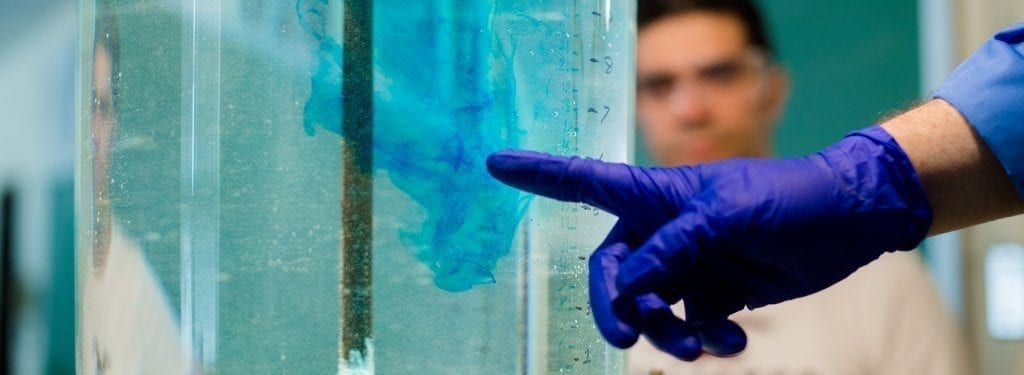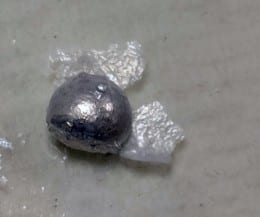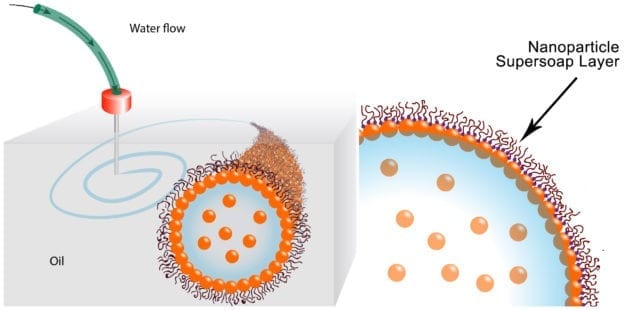
Clever, fundamental engineering could go a long way toward preventing waterborne illness and exposure to carcinogenic substances in water.
Most of us are used to turning on a tap and water coming out. We rarely question whether this will happen or whether the water is clean enough to bathe in or drink. Though the process of maintaining water quality is practically invisible to most of us, removing bacteria and contaminants from water requires a lot of effort from both humans and treatment systems alike.
Mohammad Alizadeh Fard, a doctoral student in Michigan Tech’s Civil and Environmental Engineering Department, and Brian Barkdoll, professor of civil and environmental engineering, are developing low-tech, affordable solutions to improve water quality in municipal water tanks, and to remove micropollutants from water using renewable materials.
Their research has been published in three journals—Journal of Hydraulic Engineering (DOI: https://doi.org/10.1061/(ASCE)HY.1943-7900.0001459), Journal of Molecular Liquids (DOI: https://doi.org/10.1016/j.molliq.2017.11.039), and Colloids and Surfaces A(DOI: https://doi.org/10.1016/j.colsurfa.2017.08.008)—with a fourth paper pending review. Their work proves that solutions to vexing problems can be elegant in their simplicity.
An Elegant, Low-Tech Solution
In communities around the nation, there are large water-storage tanks for municipal drinking use. Many such tanks have a line in to supply the tank with water, and a line out. However, these lines in and out are frequently at the tank bottom. Though the tanks are refilled daily, the water at the top of the tank is never used and becomes stagnant. Even though many municipal water supplies are treated with chlorine, the top water layer can become a breeding ground for bacteria, algae or waterborne illness, such as giardia and E. coli.
“If the water is not moving, (bacteria and algae) can start growing,” Barkdoll says. “It may not be originally from the water source; it could be from the air. Or the chlorine in the stagnant water could be used up after some time. You want the water to keep moving, especially in hot regions of the country.”

Keep the water circulating: Barkdoll and Alizadeh Fard’s shower head-like attachments that can be added to new or existing municipal water tanks keep water in the tanks moving, which prevents stagnation.
But if there’s a large fire in the community or surrounding countryside, the water tank is drawn down significantly, and people then drink the stagnant water.
“So, when you have a fire, all the stagnant water goes out to everybody’s house,” Barkdoll says. “After a fire, people get sick, that’s a known thing. That’s the problem that we’re trying to fix.”
To remedy the problem, Alizadeh Fard and Barkdoll created shower head-like attachments that can be added to new or existing water tanks for minimal cost. Adding a PVC-pipe sprinkler at the top of the tank, and a reverse sprinkler at the bottom of the tank, injects water into the system and keeps all the water circulating. Alizadeh Fard and Barkdoll published their article on this simple but effective system in the Journal of Hydraulic Engineering March 15. They hope it will be a low-tech solution easy for water quality managers to adopt.
Unseen Menace: Micropollutants
But organic contaminants are not the only source of contaminated water. Few municipal systems are equipped to handle micropollutants—such as pharmaceuticals, hormones, microplastics, nanoparticles in socks and synthetic fleece, and antifungal compounds—even types of industrial waste that are present in very low concentrations. Despite the small amounts—mere micrograms—of these pollutants in water, they still have carcinogenic effects on humans and aquatic creatures. Retrofitting treatment plants to filter for micropollutants is expensive, leading Barkdoll and Alizadeh Fard to explore potential solutions.
“These contaminants have long-term effects on health,” Alizadeh Fard says. “Most of our treatment plants have not been designed to remove them from water, so it’s important to find a reliable solution to address the problem.”
The Latest on: Micropollutants
[google_news title=”” keyword=”micropollutants” num_posts=”10″ blurb_length=”0″ show_thumb=”left”]
via Google News
The Latest on: Micropollutants
- Flint’s Never-Ending Water Crisis and ‘Punishment Nightmare’on April 26, 2024 at 2:41 am
Corporate executives meet in Paris, Washington delays restitution, and the city dithers over pipe replacements.
- Which foods have the most plastics? The answer may surprise youon April 22, 2024 at 4:29 pm
Sugar is also "an important route of human exposure to these micropollutants," according to a 2022 study.Even tea bags, many of which are made of plastic, can release enormous amounts of plastic.
- Which foods have the most plastics? The answer may surprise youon April 22, 2024 at 4:29 pm
Sugar is also "an important route of human exposure to these micropollutants," according to a 2022 study.Even tea bags, many of which are made of plastic, can release enormous amounts of plastic.
- Which foods have the most plastics? You may be surprisedon April 22, 2024 at 7:53 am
Apples and carrots were the most contaminated fruit and vegetable, respectively, with over 100,000 microplastics per gram. The smallest particles were found in carrots, while the largest pieces of ...
- Investor stewardship key to fight against PFAS and micropollutants says WHEB AM’s Monteiroon April 22, 2024 at 5:43 am
At WHEB, we have been addressing the risk of micropollution through our stewardship and engagement activities for more than a decade. In recent years we have ...
- MIT researchers reveal incredible method to remove array of harmful pollutants from water: 'Most technologies focus only on specific molecules'on April 14, 2024 at 3:45 am
The health of everyone depends on our society's ability to treat water for micropollutants. MIT researchers reveal incredible method to remove array of harmful pollutants from water: 'Most ...
- EU Parliament says polluters must pay on wastewater: big pharma and cosmetics companies should clean up their acton April 11, 2024 at 3:16 am
Big pharma and cosmetics companies could soon have to pay to mop up their wastewater pollution, as EU parliament approves new package.
- EU To Make Pharmaceutical And Cosmetic Industries Pay For Treating Wateron April 9, 2024 at 5:00 pm
Towns with more than 150,000 inhabitants will by 2039 have to remove all nitrogen and phosphorous, and by 2045 a wide range of micropollutants. Most importantly, the package establishes the principle ...
- Membrane technology: Looking deep into the smallest poreson February 21, 2024 at 7:16 am
Clean drinking water is of vital importance to all people worldwide. Membranes are used to efficiently remove micropollutants, such as steroid hormones that are harmful to health and the environment.
via Bing News











